 By Staff By Staff
July 8th, 2024
BURLINGTON, ON
The push is on – from the Premier himself no less.
This summer, there are still thousands of places people can buy their favourite beer, cider, wine or even spirits across Ontario. To help consumers connect with local retailers and producers close to home during the ongoing OPSEU strike, the province has launched a new searchable and interactive map of retailers that remain open and ready to serve. These retailers include more than 1,000 local Ontario breweries, wineries, wine shops and distilleries, in addition to other retailers such as LCBO Convenience Outlets, The Beer Store and licenced grocery stores that sell a range of Ontario-made and imported products.
 “This new map is a great way to connect people across the province to local Ontario-made products and support the hundreds of Ontario businesses and thousands of Ontario workers who make these products and serve customers each and every day,” said Premier Doug Ford. “It also supports our plan to offer consumers the kind of choice and convenience available to other Canadians when purchasing alcoholic beverages, starting later this summer. I hope people across the province will take this chance to shop local and responsibly enjoy some great Ontario-made products!” “This new map is a great way to connect people across the province to local Ontario-made products and support the hundreds of Ontario businesses and thousands of Ontario workers who make these products and serve customers each and every day,” said Premier Doug Ford. “It also supports our plan to offer consumers the kind of choice and convenience available to other Canadians when purchasing alcoholic beverages, starting later this summer. I hope people across the province will take this chance to shop local and responsibly enjoy some great Ontario-made products!”
 The new convenient and easy-to-use map can help users find a location that sells beer, wine, cider, spirits or ready-to-drink beverages. The map will be updated regularly as alcohol sales are expanded to more licensed grocery and convenience stores. As LCBO retail stores re-open, these will also be added to the map. The new convenient and easy-to-use map can help users find a location that sells beer, wine, cider, spirits or ready-to-drink beverages. The map will be updated regularly as alcohol sales are expanded to more licensed grocery and convenience stores. As LCBO retail stores re-open, these will also be added to the map.
“Our government is delivering on its commitment to expand the province’s beverage alcohol retail marketplace to increase choice and convenience for shoppers earlier than planned,” said Peter Bethlenfalvy, Minister of Finance. “Ontario can rest assured there are more options to purchase than ever before, thanks to the government’s bold plan to modernize alcohol sales.”
As announced in May 2024, Ontario is expanding the province’s alcohol beverage marketplace in phases to allow convenience, grocery and big-box grocery stores to sell beer, cider, wine and ready-to-drink alcoholic beverages, such as coolers, hard seltzers or other premixed cocktails.

 By Pepper Parr By Pepper Parr
July 6th, 2024
BURLINGTON, ON
It was a hot Saturday morning which didn’t seem to deter the band of about 25 people who chose to do a walking of parts of ward 2 with Councillor Lisa Kearns.
 Tour started off at the No Frills plaza – towers in the background, all south of Caroline, have in the minds of many, destroyed the feel of the downtown core. Lisa spent half an hour talking about the her view of the ward as she saw it, explaining what a city Councillor could say and do and what they couldn’t say and do, giving her view of the ward as she saw it and then walked the group up Brant Street and point out where the development was going to take place and what she liked and didn’t like about some of the developments.
 Maps with development details were handed out.  He is certainly paying attention. The concerns were always about height and density and the size of the units that would be organized as rental units. Not much mention of park space.
The development at 795 Brant has been an issue for council. The developer wanted to demolish the building arguing that it had little in the way of heritage value. The matter went to the Ontario Land Tribunal where a settlement has been worked out. That story will be a seperate article later in the week.
 The house, one of the last farming houses left standing in the core of the city, has been a Land Tribunal issue that is at the settlement stage. Exactly where the house will be located is not yet clear.  Tour ended at Brant and Prospect where there is a very controversial development taking place on an oddly shaped piece of property. 
 By Eric Stern By Eric Stern
July 6th, 2024
BURLINGTON, ON
Let me tell you why I started a petition to stop the proposed 8.9% increase in 2025 Burlington property taxes. Burlington City Council has a spending problem”.
My petition asks the city for three things,
a zero percent increase in taxes for 2025,
clear language when communicating tax increases,
and an understandable budget.
1 – No increases in 2025
When talking about tax increases in Burlington, the city and Mayor Meed Ward often talk about the impact of the increase on our tax bill.
When talking about a budget only two things matter.
1 – The percentage increase.
2 – The dollar value increases.
The last municipal election was in 2022. On our final tax bills, for 2023, there is a line starting with M – Municipal line, that showed an increase that amounted to 15.59%.
Your 2024 tax bill would show, at the same place M – Municipal line showing an increase of 10.21%.
 The budget numbers for 2022 The approved budget for 2022, operating and capital combined, was $362.1 million.
 The numbers for the 2023 budget. The approved budget for 2023, operating and capital combined, was $434.8 million.
That’s an increase of $72.7 million taken in by the city from tax payers over a two years period.
How can the city possibly spend $72.7 million on the things that benefit the tax payers in such a short period of time?
That’s not easy for any organization to do. The city could have used the funds to pay down debt or top up reserves, but that does not appear to have happened.
This following statement on the city’s debt level is from the 2024 approved budget:
 “The City has an estimated $73.8 million in total principal debt outstanding. Taking into consideration principal debt repayments of $14.2 million, $54.7 million in debt issued and $47.7 million in debt, which has been approved and not issued, total City principal debt outstanding and remaining to be issued at year end 2023 is $162 million.” “The City has an estimated $73.8 million in total principal debt outstanding. Taking into consideration principal debt repayments of $14.2 million, $54.7 million in debt issued and $47.7 million in debt, which has been approved and not issued, total City principal debt outstanding and remaining to be issued at year end 2023 is $162 million.”
Did the author of that statement understand what it means?
In this video, Chief Administrative Officer (CAO) Hassaan Basit spoke of the need to show taxpayers the value they will receive from the proposed 2025 – 8.9% tax increase that will appear on the M-Municipal line on your tax bills when they are issued in 2025 – assuming of course that the increase is not greater than 8.9 %. .
Before talking about further significant tax increases (that being the 8.9% increases the city department is projecting), the city needs to show what value taxpayers have received from the 2023 and 2024 increases. With 72.7 million additional dollars it’s hard to imagine that the sky will fall, despite what the City Manager said.
2 – Clear Language when communicating tax increases.
Burlington has an Engagement Charter that has the following statement: “Clear Language: The City of Burlington will use plain and clear language in documents and public communications that is more engaging and understandable for citizens than technical language and jargon.”
For 2025 the proposed increase is 8.9%. This is how the mayor explains this increase on her website “the 2025 Proposed Budget. Staff are predicting a total tax increase of 5.5%, of which the City’s portion would be 4.5%.”
The reality is that the proposed budget increase is 8.9%, and the M-Municipal line on your tax bill will show that 8.9% increase. . The mayor needs to stop freeloading on the other parts of our tax bill to make her increases look somewhat acceptable.
Using the approved 2024 budget total of $434.8 million – 8.9% of that amounts to $38,697,200 of additional dollars for the city to spend.
3 – Share the details of the budget in a way the community can understand them.
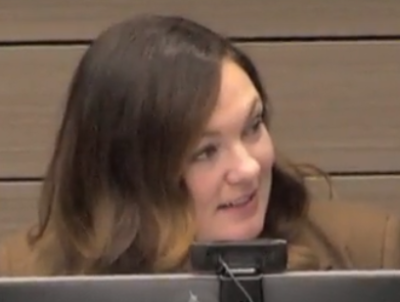 Ward 2 Councillor Lisa Kearns: “I would call it like mumbo jumbo.” Ward 2 Councillor Lisa Kearns, speaking to a community meeting about the budget said: “The budget is really hard to understand. I would call it like mumbo jumbo. Its 700 pages. “ Kearns is one of the brighter members of this Council and is usually able to figure out complex document. For a more in depth look at what Kearns told her constituents click HERE.
City staff, people that are paid with money tax payers provide, prepare a budget that Kearns called “mumbo jumbo. The people given the 700 pages from city staff – the people we pay to represent us then have to deal with the “mumbo jumbo”
How is this mumbo jumbo possible?
 Doreen Sebben 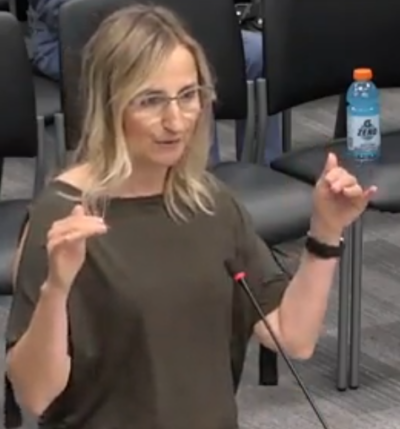 Lydia Thomas Our councillors have failed to insist that staff use language that is easily understood and graphics that help make the point. They have allowed this situation to get out of hand. Kearns talks about change, and there have been some changes – they were the result of and a response to excellent delegations from Lydia Thomas and Doreen Sebben.
Kearns complains about mumbo jumbo but it takes citizen action to force changes. We elect council members to work with city staff on our behalf. What has this council been doing? The budgets have been confusing for years. The M-Municipal line on the tax bill increases have become so large that citizens are having to complain directly to the council. Maybe our councillors are starting to wake up and talk about change. We’ll have to wait and see if this is just talk or if there will be real change.
One question remains, why wasn’t something done about the mumbo jumbo years ago?
Something is rotten in the state of Burlington.
Please consider signing the petition:
 Eric Stern is a retired business owner with a keen eye and a desire to keep his dollars in his wallet. When the dollars come out of his wallet he expects value in exchange for the money. He does not feel the city is giving him measurable value. Eric Stern is a retired business owner with a keen eye and a desire to keep his dollars in his wallet. When the dollars come out of his wallet he expects value in exchange for the money. He does not feel the city is giving him measurable value.

 By Pepper Parr By Pepper Parr
July 6th, 2024
BURLINGTON, ON
For reasons that we cannot fathom we are not able to tell you the names of the four people who are going to be named as Commissioners in the new city staff organizational structure.
We are not doing all that well in getting direct, clear and concise answers to our questions from the City communications group about the changes that are being made on the corporate organizational chart.
 Hassaan Basit, Chief Administrative Officer for the City of Burlington took office late in April. We’ve known for some time that the title of Executive is being dropped and that the staff organization would be divided into Divisions. The decision as to who will hold which senior level jobs is determined by the Chief Administrative Officer (CAO) traditionally called the City Manager.
We are told that the “Communications and Engagement team now reports to the Head of Corporate Affairs per the org chart shared previously. There is no hierarchy change within the team.
“Members of the executive team (including Commissioners) will begin to attend Committee of the Whole (COW) and Council meetings as their roles are confirmed and their schedules allow.
That sounds as if the new “Commissioners” will become known when they first speak at a Council meeting.
Council will meet next week – maybe the names and faces will be revealed then.
The City Clerk, a critical staff person, bylaws are not law until the Clerk signs the document does not appear on the current organization chart.
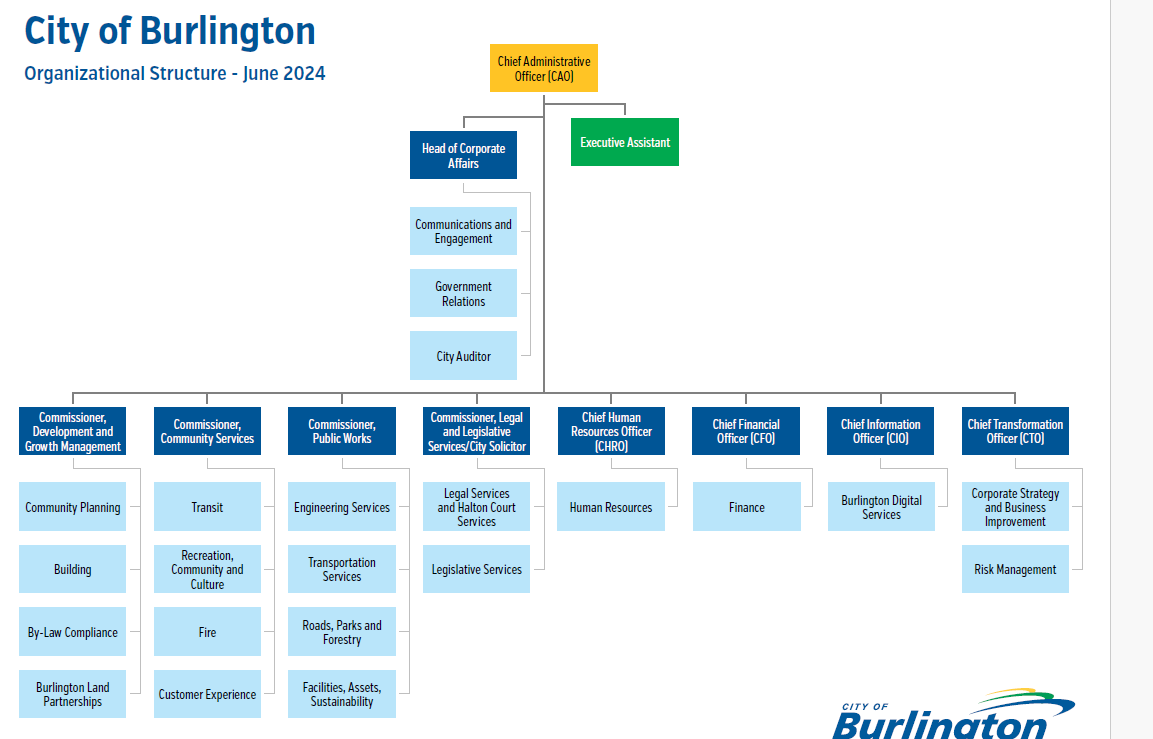

 By Pepper Parr By Pepper Parr
July 6th, 2024
BURLINGTON, ON
Using X – known as Twitter, Marianne Meed Ward announced that her communications advisor is moving on,
Meed Ward said: “It is with mixed emotions that I announce John Bkila, Specialist, Media & Digital Communications, will be leaving the Mayor’s Office team to pursue a new opportunity. His last day in our office will be Thursday, July 11.
Recruitment has begun and is open for applications here:
 John Bkila, Specialist, Media & Digital Communications, John has been with me since the beginning of my tenure as Mayor, and in that time has significantly grown the reach and impact of the Mayor’s Office communications and engagement with residents. The information he has provided with the monthly newsletter and daily social updates, and other tools, has engaged residents in the day to day activities and decisions we make with their input and on their behalf.
 John Bkila at a public event that did not include the Mayor; are there tea leaves to be read. Residents have frequently commented to me how valuable they have found this information.
John also guided our communications throughout the COVID pandemic, working tirelessly whenever called upon to ensure our community members had the information they needed to stay safe and healthy.
We will miss John, but wish him well on this new step in his career!
Please join me in thanking John for his service to Burlington, and wishing him well.
Bkila was a staff reporter with the Burlington Post when he was poached by the Mayor to direct her social media campaigns.


 By Pepper Parr By Pepper Parr
July 5th, 2024
BURLINGTON, ON
UPDATE: The Arts & Culture 2024 budget is $1.9M

We checked it out. Here is the deal:
The City of Burlington is one of four municipalities in Halton working with Halton Region Heritage Services to commission a multidisciplinary artist, artist team or artist collective to lead an interactive cultural activity for Culture Days. Artists, artist teams, and collectives can submit their proposal to lead a participatory program, project or workshop. Proposals may include:
interactive art projects,
hands-on workshops, and/or
interactive performances.
The project should allow for audience participation, take place between Sept. 20 and Oct. 13, and be offered in each of the four regional municipalities:
 Halton’s four municipalities. Burlington
Halton Hills
Milton and
Oakville
The deadline for online submissions is 4 p.m. on July 31.
For more information, visit the Halton Hills Call for Artists website.
The project should:
include a community-based activity in each of the four municipalities to connect the Halton Region.
be clearly tied to Culture Days, celebrate Halton Region’s 50th anniversary and create a sense of unity and collaboration within the community.
take place indoors.
be engaging and offer a platform for individuals to express themselves and contribute to a larger dialogue about the theme of home and belonging.
allow attendees to participate in the activity and be free to attend.
be designed as a drop-in for large group participation.
The commission for the project is $6,000. This amount includes $2,000 for material costs.
Culture Days is an annual celebration of arts, culture and creativity that increases community access, provides hands-on participation and highlights the importance of arts and culture in our communities. Every year, free arts and cultural events are offered as part of the celebration, encouraging participants to create, share and celebrate arts and culture. Halton’s four municipalities have partnered with Halton Region Heritage Services to help celebrate the Region’s 50th anniversary during the 2024 Culture Days festival.

 By Jacob Robinson By Jacob Robinson
July 5th, 2025
BURLINGTON, ON
Organizing A Study Session: What To Plan
 Organizing a successful study session requires careful consideration and preparation. Effective studying is a cornerstone of academic success, and thorough planning is absolutely crucial. Whether you’re a high school student preparing for exams, a college undergraduate tackling complex coursework, or an adult learner balancing education with other responsibilities, organizing a successful study session requires careful consideration and preparation.
Setting Clear Objectives
Before diving into your study materials, it’s crucial to establish clear, specific objectives for your study session. What do you hope to accomplish? Are you aiming to master a particular concept, review a chapter, or complete a set of practice problems?
Why not try the SMART goal-setting framework: Specific, Measurable, Achievable, Relevant, and Time-bound? For example, instead of a vague goal like “study biology,” a SMART goal might be “review and summarize the key concepts from Chapter 3 on cell biology within two hours.”
By setting clear objectives, you give your study session direction and purpose. This clarity helps maintain focus and provides a sense of accomplishment when you meet your goals.
Choosing The Right Location
If you’re studying at home, choose a specific area for learning. This could be a desk in your bedroom, a corner of the living room, or even a spot at the kitchen table. The key is to choose a location that you associate with focused work and that minimizes distractions.
 Create a study space that is distraction free. For those who prefer studying outside the home, consider locations like libraries, quiet cafes, or dedicated study spaces on campus. When selecting your study location, consider factors such as:
- Noise levels: Do you work best in complete silence, or do you prefer some background noise?
- Lighting: Make sure you’ve got enough to prevent eye strain.
- Comfort: Choose a space with comfortable seating and appropriate desk space.
- Access to resources: Make sure you have access to necessary materials, including internet connectivity if needed.
Gathering Necessary Materials
Nothing derails a study session faster than realizing you don’t have the materials you need. Before you begin, gather all necessary resources. This might include:
-
-
- Textbooks and course materials
- Notebooks and writing utensils
- Laptop or tablet
- Calculator or other subject-specific tools
- Snacks and water to keep you fueled and hydrated
If you’re using digital resources, make sure that you’ve downloaded any necessary files or applications before your study session begins. This prevents time-wasting technical issues once you’ve settled into your work. For example, if you’re looking for study notes for your exam prep, make sure you’ve got them to hand. Studocu has an amazing range of lecture notes and study material from institutions around the world. Visit their website to find out more.
Creating A Realistic Schedule
Time management is crucial for an effective study session. Create a realistic schedule that breaks your study time into manageable chunks.
The Pomodoro Technique involves working in focused 25-minute intervals (called “Pomodoros”), followed by short breaks. After four Pomodoros, take a longer break of 15-30 minutes.
When creating your schedule, consider your personal energy levels and attention span. Some people work best in longer stretches, while others benefit from more frequent breaks. Experiment to find what works best for you.
Remember to build in time for:
- Short breaks to rest your eyes and stretch
- Meals and snacks
- Brief physical activity to boost energy and focus
- Reviewing and summarizing what you’ve learned
 Active learning strategies that engage your mind and improve retention. Incorporating Active Learning Strategies
Passive reading or re-reading is often an ineffective study method. When planning your study session, incorporate active learning strategies that engage your mind and improve retention.
Some effective active learning techniques include:
- Summarizing: Plan to summarize key concepts in your own words after studying a section.
- Teaching: Prepare to explain the material to an imaginary student or study partner.
- Creating concept maps: Schedule time to visually represent the relationships between different ideas.
- Applying knowledge: Plan to work through practice problems or case studies that apply the concepts you’re studying.
Planning For Potential Distractions
 You need to anticipate and plan for potential interruptions. Look for apps to block distracting websites and apps during your study time. If you’re studying in a shared space, communicate your study plans to family members or roommates to minimize interruptions. You need to anticipate and plan for potential interruptions. Look for apps to block distracting websites and apps during your study time. If you’re studying in a shared space, communicate your study plans to family members or roommates to minimize interruptions.
If you find your mind wandering to unrelated tasks or worries, keep a notepad nearby to jot down these thoughts. This allows you to acknowledge them without derailing your focus.
Incorporating Physical Activity
Physical activity can boost your cognitive function and help maintain focus during long study sessions. When planning your study time, factor in short bursts of physical activity.
 Incorporating stretch exercises – even if it just five minutes – will improve your frame of mind. This could be as simple as planning a five-minute stretch break every hour or scheduling a brisk walk between study blocks. You should be getting at least 150 minutes of moderate to vigorous physical activity per week, so integrating movement into your study routine can contribute to this goal.
Planning For Self-Care
Make sure you schedule regular meals and healthy snacks to keep your energy levels stable. Plan for adequate sleep before and after intense study sessions. You really should be getting between 7-9 hours of sleep per night.
Also, think about incorporating stress-management techniques into your study plan. This might include short meditation sessions, deep breathing exercises, or brief periods of mindfulness practice.
Exam prep can be an incredibly tough time, but you can give yourself the best platform to succeed when you plan and organize.
ADD IN

 By Pepper Parr By Pepper Parr
July 5th, 2024
BURLINGTON, ON
Burlington MP Karina Gould is the House Leader for the Liberal party and these days she is a busy women.
Despite officially being on maternity leave Gould made an announcement during the week of an $8.5 million funding in the form of loans to n!Biomachines, Aethon Aerial Solutions, GL Chemtec International, JFE Shoji Power Canada, Merk Automation Inc, and M&G Steel.
 The next federal election is going to be a tough one. Should Gould hold the Burlington seat she is there for as long as she wants to be an MP. A Prime Minister as well: Karina Gould has never talked about that role. At a different media event Gould, as Liberal House leader, said the Liberal caucus will gather in September in Ottawa during which Prime Minister Trudeau will address the concerns Liberal MP’s have with the Toronto St.Paul results.
The loss of the Toronto St Paul riding by-election earlier this month was a shock to the Liberal party that is now in the midst of deep concerns over Justin Trudeau’s statements that he intends to run in the next federal election when it is called. It is currently scheduled for October 2025, however the Prime Minister can call an election at any time.
Christina Alexandra Freeland, Minister of Finance and Deputy Prime Minister, held a meeting of all the Cabinet ministers in the 416 area code and reports that they are unanimous in wanting the Prime Minister to lead the Liberal party when there is an election.
The Prime Minister has said that he will not hold an everyone in the room caucus meeting in the near future, instead holding one on one conversations with individual members of Parliament.
The Prime Minister is taking a pass on attending the Calgary stampede – nothing but bad news for him at that event.
Last week we ran a story on the devastating loss of the Toronto St Paul riding and asked Gould if she thought that had ranked balloting been in place would the Liberals have held the riding?
 Ranked balloting has the potential to change in a fundamental way how people are represented in the House of Commons. Dave Meslin, a leading advocate for a change in the way the Members of Parliament are elected said that had ranked balloting been in place ‘the Liberals would probably have won that Toronto St. Paul by-election.
In December of 2015, an all-party House of Commons committee released a report recommending the Liberals design a proportional representation voting system and hold a national referendum to gauge support.
At the time, the Liberals refused to knowledge a consensus; and in 2017 ,Trudeau directed the minister of democratic institutions, Karina Gould, to abandon electoral reform altogether.
In 2017 Gould stood before a media scrum and said the government was not going to follow through on its 2015 promise.
We reached out to Gould asking her for a comment on how the Toronto St. Paul by-election result might have been different if ranked balloting had been in place.
Gould responded saying: “Thank you for reaching out. I stand by the decision the federal government made in 2017 not to pursue electoral reform further. There was no consensus at the time as to how to move forward. When doing something as big as changing how we elect governments in this country, there should be a clear call for how to make that change.
“The results in Toronto St Paul’s are certainly disappointing for us as a Liberal Party. However, voters were clear they wanted to send us a message and that message has been heard. We will be taking the summer to reflect and listen to Canadians across the country and come back energized for the year ahead.”
Political pundits, and this country has more than its share, are pitching in with their views. One said is a posting made yesterday that:
Of the 155 Liberal MPs, 100 or more face defeat in next year’s election, a fate their party leadership has been unable to change. Not a single poll has shown federal Liberal support at or above 30 per cent since mid-September, 2023. In June polls pegged the Liberals as low as 21 per cent.
It is exactly those MPs, fuelled by panic without a plan, who are now the greatest threat to the Liberals. The worst possible outcome for their party is not a controlled crash landing that defeats 100 Liberal MPs in next year’s election. Worse would be an uncontrolled descent caused by fighting in the cockpit and disorder everywhere that causes a lot more devastation on impact.
Panic risks an outcome where the Liberals represent Anglo Montreal and few scattered outposts held on anomalous vote splits.
Without any replacement in the wings capable of boosting Liberals back to a competitive position, the smart move is for the Liberals is to turtle-up and protect as much as possible.
 Which brings us back to Burlington. Is the Burlington seat at risk? Can Gould defeat the Conservative candidate – it looks like Emily Brown will win the nomination – no date yet set for a Conservative nomination meeting. Which brings us back to Burlington. Is the Burlington seat at risk? Can Gould defeat the Conservative candidate – it looks like Emily Brown will win the nomination – no date yet set for a Conservative nomination meeting.
Related news story:
Ranked balloting – why not?
Would the Liberals have won Toronto St Paul if the ballot counting had been ranked?

 By Pepper Parr By Pepper Parr
July 4th, 2024
BURLINGTON, ON
 Jim Thomson – a persistent delegator Jim Thomson, a citizen who delegates frequently, albeit as a virtual participant, asks a serious question.
Why is a Motion to pass a bylaw going directly to Council and not part of an item on the Committee of the Whole agenda?
The Motion details are set out below.
NOTICE OF INTENTION TO PASS A BY-LAW
TO STOP UP AND CLOSE PART OF THE ASSUMED ROAD
ALLOWANCE KNOWN AS ELIZABETH STREET BEING A TRIANGULAR SHAPED PARCEL OF LAND ABUTTING 2030 CAROLINE STREET (formerly known as 511, 515 John Street, 2020, 2022, 2024, 2026, 2028 Caroline Street)
File 575-04-J.01
(DA-05-24, March 3, 2024)
The Council for the Corporation of the City of Burlington, at its meeting to be held on July 16, 2024, intends to pass a by-law to stop up and close part of the assumed road allowance known as Elizabeth Street being a triangular shaped parcel of land described as Part of Lot 1, Block B, Plan 92, designated as Part 7, 20R18672 (being Part of PIN 07067-0023 (LT)), in the City of Burlington, Regional Municipality of Halton, and sell the lands to the abutting registered owners of 2030 Caroline Street.
At this meeting, Council will hear in person, or by his or her counsel, group of persons, or organization who claims their lands will be prejudicially affected by the said by-law. Delegations must register with the City Clerk’s Department by noon on July 15, 2024, either in writing, by fax (905) 335-7675, by e-mail cityclerks@burlington.ca or by telephone (905) 335-7600 (ext. 7805). Each delegation is allowed a maximum of five minutes to present their support or opposition to the by-law.
For further information on this proposed by-law, please contact Kristen Ljubicic, Realty Manager at 905-335-7600 ext. 7581 or kristen.ljubicic@burlington.ca.
There is no map or illustration of the piece of land nor any mention of its size. It would appear to be related to the development of the lots north of the Berkeley condominium where a parking garage and an additional tower are planned.

 By Pepper Parr By Pepper Parr
July 4th, 2024
BURLINGTON, ON
During her lengthy ward meeting Councillor Lisa Kearns did much more than open the kimono. We got to hear what she likes and doesn’t like – delivering a budget that has veto powers; the Strong Mayor powers; parts of which the Mayor is hanging on to are not what Kearns wants to see.
Note: This article is edited for length and clarity.
Kearns set out for her audience the schedule Council will follow in getting a budget passed before the end of the year.

Kearns pointed out that taxes are the lowest or on the lower side when compared bungalow to bungalow.
The following is from BMA, a consulting group that provides data to most of the Ontario municipal sector.
 
There is a little bit of opportunity to bring some clarification around the way things are presented to be a little bit more transparent, because the assessed values are a bit different, said Kearns.
“But what does that mean when it hits your back pocket? So it’s a little bit different, even though we say, “Oh, look how low we are” it still stings a bit when you get your tax bill and we’ve yet to have reassessments. Just want to make a point of clarity, we haven’t had a tax reassessment on property assets since 2016.”
While Kearns didn’t actually say ‘this is another punch coming our way’ – it is going to hurt when it lands. Kearns said she believes the provincial government has put them on pause.
“This is the schedule that’s been tabled, and you’ll notice that there’s a giant window called August to October At that point we don’t really have anything to work from.
“There are a couple of guiding documents, some concepts like affordability, future growth planning, infrastructure sustainability, but you don’t really know what’s coming out.
“This is going to be the time to hear from you about what you’d like to see in the budget. But we don’t really know what we’re working towards; I know that there’s some pressure coming down to bring working groups forward. I’m happy to lead one of those in my ward. I’ve had some kind of preliminary conversations around people who are putting up their hands to say, hey, I really want to get into this budget, and I really want to see some savings and see how the city is optimizing their resources.”
“We’ve brought a lot on board in the last number of years. We’ve just received a financial assessment report, and our debt ceiling has climbed and our reserves have lessened.”
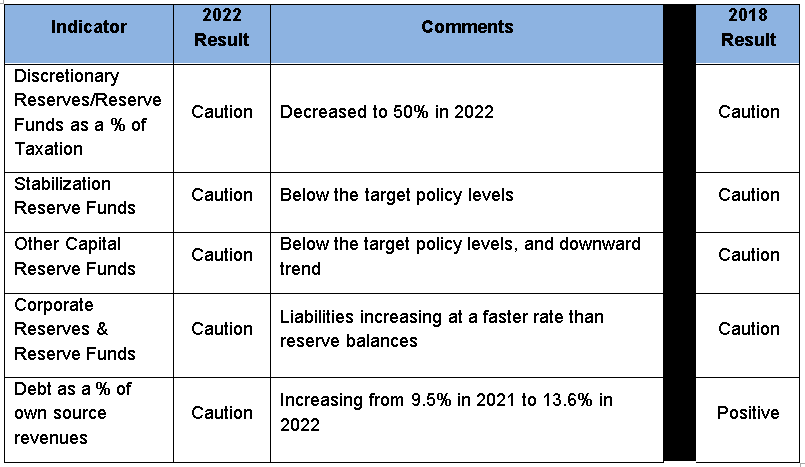

“So we want to bring those two things a little bit closer. We want to build up those reserves again for the next councils, especially tax stabilization. I made a kind of oath to myself to never touch anything no matter how noble the cause is, if it’s coming out of tax stabilization reserve fund. No, nice to haves, no to anything. I don’t care. No, unless it’s like literally a burst pipe. We’re not touching it.
“The mayor has to prepare the budget based on what the financial forecast or Outlook is that will be prepared by staff. So old style, we get a big book from the staff, we bring it out to the community. Hey, look at this. What do you like? What do you not like?
“Amendments can be made to that. We’ve got about three and a half weeks between that budget, which is the real budget to work off of based on the municipal legislation, but a few weeks to work off of that and make some changes. Those are called motion memorandums
“My community wants a splash pad. We need a walking path here. Take that out. We’re not going to finance, you know, X millions of dollars towards this Community Improvement Plan. That cannot wait; but they say they are going to do it incrementally. That’s when we get to have that bigger finance conversation.
“I’m hearing from the community that people want a monthly touch point where it’s kind of like open mic night on budget, and there’s a call out for a standing item. I just have to figure out how to do this procedurally, a standing item on all of the Committee of the Whole agendas related to the budget.
At the socioeconomic level BMA had this to say about Burlington.
 
 Kearns: “my stress levels are through the roof” “The budget is really hard to understand. I would call it like mumbo jumbo. Its 700 pages. It lands. You’ve got three weeks to eat through it. It’s so difficult. I know my stress levels are through the roof. I usually like lock myself in a room for those three weeks. It’s not healthy, and they can’t have great conversations, because it’s a lot to digest, to understand, and it doesn’t go by Ward, so I don’t have the ability to say, Well, what’s happening in my ward? We want to look through this.
“Maybe we don’t need this anymore, but this street really needs to get repaved. I know some streets want curbs; they want a proper walking sidewalk. Some streets are in protest against sidewalks. We need to have those conversations, and we need to have the time to have them. I’m hoping that we can kind of pull those priorities out, or at minimum, I can deliver a ward budget priority list that can help inform either of these budgets. So still looking through it, stay tuned.
“People are asking for a ward 2 budget working group. I can’t dip by myself, so I always invite you to come alongside me.
 “We need a stronger lens on the actual changes in the budget.” “Am I really going to override the budget? Probably not. It gets deemed approved. So little bit finicky when you get to that last part. But that’s all procedural based on the way that the provincial government has laid out how we do budgets.
“There will be delegation opportunities throughout the course of this, each time something comes through. But again, if you don’t know what you’re actually talking about, because it’s still locked up in political mumbo jumbo and a 700 page book, and you don’t know what they’re actually saving or who’s getting a new position? Have you got rid of any positions? Or do you just keep adding the positions?
“Think we need to have, like a stronger lens on the actual changes that are happening within the budget.”
Related news content:
How the budget will be presented.
Templates that will be used to present budget data

 By Pepper Parr By Pepper Parr
July 4th, 2024
BURLINGTON. ON
Can we blame this one on Steve Cussons?
Probably not – we ran a story earlier today on the Automobile show that we understood was taking place this Saturday on Brant Street.

We were wrong – the event was cancelled, due to events the organizer of the event could not control. No mention as to just what those events were from Steve Cussons who owns the rights to the show.
Next year.
Some of the articles we publish are prepared beforehand and scheduled for publication on a specific date. This was one of them. The City Communications people were decent enough to point out our error. Thanks

 By Pepper Parr By Pepper Parr
July 4th, 2024
BURLINGTON, ON
So – how many people took part in the Sound of Music Festival this year?
 The crowds were there – but no one has issued an official count. No word yet on what the count was; given that the city had to come through with a last minute bail out of $125,000 – during her ward meeting Councillor Kearns said the amount was $150,000 – one would have thought they would release the number as soon as they were available.
 The fans do get excited. They pay a premium to be able to be at the foot of the stage. There are mixed views floating around on whether or not the event has reached its best before date.
The crowds were certainly there when we looked.
Wasn’t isn’t in place is a level of governance that is now a must have for any organization that gets funds from the City.
The Performing Arts Centre had a set of governance requirements put before them – and they complied. And they picked up the cost of the person who created the report.
One of the unfortunate parts of the problems at BPAC was the abrupt departure of the Executive Director. No official word but there were problems with some of the relationships that existed that aren’t part of a well-run corporation that exists to a considerable degree on public money.
That chapter of BPAC’s history is behind them.
 Former president of Cogeco, Ken Smithard has kept the organization stable as it went through a very difficult stage. Will he be asked to stay on while BPAC determines what it might be able to do with the Sound of Music? A new Board is now in place. Current Board chair Ken Smithard is nearing the end of his term and has said there is a very strong board in place – several who could step in when his term comes to an end.
At this point they BPAC appears prepared to look at creating a stronger bond between the Sound of Music and the Performing Arts Centre – but the Sound of Music people are going to have to clean up their act quickly before anything can be done.
 Taking part in a virtual Council meeting from his van Dave Sheppard said he would step and run the organization to get it back on its feet. Telling people that the bands need to be paid in cash and thus the need for hard dollars – how does one create a paper trail when cash is involved? Does the Sound of Music get receipts for the dollars they hand over?
There is some very hard thinking that needs to be done and then some hard work if the Sound of Music is going to continue. There are those who have a lot of influence within city hall who don’t see enough in the way of real benefit to the city for the show to continue.
The one thing the Sound of Music does have is a band of volunteers who do the hard volunteer level work that gets the show on the road and the clean up that follows.
A number of years ago they tried very hard to bring about changes in the way the event was run – they were stiffed by the SoM at the time.
There is more to come on this event.

 By Staff By Staff
July 4th, 2024
BURLINGTON, ON
Few expected there would be a rooftop platform at the Joseph Brant Museum that is probably the best place to look over Spencer Smith Park and the Pier.
The Museum is introducing a new summer event and a fun way for the whole family to enjoy your local community museum.
 Rooftop of the Museum has become a hot spot to enjoy a superb view of Spencer Smith Park and the Pier. Listen to live music from the rooftop from 7:30pm – 8:30pm on July 12 & 26 and August 9 & 23 for the “Music From the Rooftop” series.
Each evening will feature a local musician, lawn games, and complimentary iced tea and popcorn. Doors will open at 6:30pm to allow guests the chance to browse the museum’s galleries prior to the performance.
Tickets are $15/adults, $13/seniors & students, $11/children (ages 3- 12). $40/family (2 adults and up to 4 children). Ticket includes 1-hour musical performance, lawn games, complimentary refreshments & popcorn, admission to museum galleries.
In the case of inclement weather, performances will happen inside Joseph Brant Museum’s Lakefront/Shoreline rooms.
July 12 – Annie Bonsignore
July 26 – Natalie Reis
August 9 – Michelle Hedley Acoustics
August 23 – Hayley Verrall
For information and tickets, visit museumsofburlington.ca.

 By Emma Wilbert By Emma Wilbert
July 4th, 2024
BURLINGTON, ON
Summer is one season every Canadian looks forward to. With low temperatures over half of the year, it’s no surprise that Canadians gladly embrace the summer’s rays of sunshine and warm weather.
While summer is a great time for individuals to get an academic break or a work leave, it is also a good time for families to host picnics, attending festivals, and other outdoor events. For premium safety and fun, it is important that families visit family-friendly locations. Here’s a selection of the best family-friendly locations in Burlington, Ontario.
 From the top of Mt Nemo you can see the Toronto skyline on a clear day. Easy to navigate paths lead you to the viewing station at the top. Mount Nemo Conservation Area
If you love the good ol’ nature parks, then you’d love Mount Nemo. The conservation area is located on Guelph Line. It has a distinguished ecosystem of different plants and animals. The park has a climbing route, caves, and cliffs that will make you feel in tune with nature.
Mount Nemo is also an ideal educational tour for kids, as they will experience the biodiversity of rare species coming to life. You should come along with binoculars and magnifying glasses to capture the vast beauty of this mountain.
 Trumpeter Swans and geese make the waterfront of LaSalle Park home along with the marina. LaSalle Park
The beautiful sites in LaSalle Park have illuminated its surroundings on Burlington’s lakefront in Aldershot. The park’s breathtaking waterfront, trails, and grass make the perfect background for evergreen pictures. LaSalle Park is also home to one of Ontario’s most precious architectural pieces, the rebuilt pavilion. Trumpeter Swans live along the lakeside of the park.
If you’d love to host a family picnic, you’d love LaSalle Park. With a well-maintained court and playground, your kids will have a great time running around and flying kites. There is also a wading pool that is popular to cool off in and there is the possibility to play some baseball.
While the kids are having a good time, you could entertain yourself with some online games from the top casinos with the highest payouts. You just may hit the “jackpot” and leave the park with some extra cash. To enjoy your time at LaSalle Park, it’s best to bring along mats, towels, and bathing suits.
City View Park
The history of City View Park is similar to the proposed 350,000 hectares of cattle farm at Vergemont Station in Australia to be converted to a park. The 165-acre farm located on Kerns Road near Dundas St., west of Brant St., was converted to a park in June 2012.
City View Park comprises several sports fields, bike trails, and a playground. This naturalized park has good lighting, allowing visitors to enjoy a smooth bike ride. There are also washrooms where you can shower and change after a long ride. If you are a family of cyclists, then City View Park is a place you should visit.
 One of the 12 themed areas at the Royal Botanical Gardens in Burlington Royal Botanical Gardens Hendrie Valley Sanctuary
Hendrie Valley Nature Sanctuary is almost as grand as Australia’s Royal Botanic Garden Sydney. With its colourful view of various flowers, the 100-hectare Hendrie Valley Sanctuary is situated in the Grindstone Creek Valley.
Other unique features of the Hendrie Valley Sanctuary are the trails of over 4 kilometers and the large cultivated garden of over 1,500 plant species. That’s not all; the Royal Botanical Garden is divided into 12 themed areas where you will find a rose garden and a vegetable garden with an interesting collection of sculptures.
If you are working on a shoestring budget, the Hendrie Valley Sanctuary is the place to visit. You can access the trails via bus, bike, or simply walk at no cost. However, fees may apply if you want to access the gardens.
Lowville Park
This park is one of the busiest parks in Burlington. The reason is not far-fetched, as the park is graced with a clean creek with tiny fish, lush vegetation, and a fairytale iron bridge.
Lowville Park is great for family picnics and games. There is a washroom for you to freshen up and a little store where you can get ice cream. The kids can get busy in the old stone schoolhouse and playground. To have a great time at Lowville, come along with soft balls and frisbees.
 To the right of this scene there is a pier that juts out into Lake Ontario. Spencer Smith Park
This park has a fascinating history. The land was initially gifted to Joseph Brant for his loyalty to the crown during the American Revolution. Over time, the land was eroded because of its proximity to Lake Ontario, which required the federal government to build a seawall in 1939. In the same year, the Burlington Horticultural Society cleared the shoreline and renamed it Spencer’s Smith Park after its former president. This park is a great way to engage your kids in some history lessons about land ownership and transfer.
Today, Spencer Smith Park is the best place to get a breathtaking view of the beach, Lake Ontario, and even the Skyway Bridge. Whether you choose to take a walk or cycle, the park presents you with a fantastic view of the lake. Locals often gather at Spencer Smith’s Park for outdoor events. You could visit the park during an event to enjoy the view and activities. Other historic park features include a children’s playground, a Terry Fox monument, a Lady of the Lake bronze sculpture, and Naval War memorials.
Final Thoughts
To access any of these locations, you’d have to make reservations in advance, so it’s essential that you start planning early. You can visit the official website of the locations highlighted here to learn about the cost of entry and other materials you may need to bring along.
Remember to choose a location that suits your pocket and ensure that you keep abreast of local news and events. Whatever your preference from our recommendations in this piece, you can rest assured that your family will enjoy the time spent together.

 By Pepper Parr By Pepper Parr
July 3rd, 2024
BURLINGTON, ON
Last night ward 2 Councillor Lisa Kearns held a ward meeting that was both live for the 40 odd people in the room and for anyone who wanted to take part virtually.
 It is something every member of Council might consider doing. It is something every member of Council might consider doing.
Kearns held that audience for a full three hours – answered every question she was given and ventured into areas that are not city matters – the school board being one of them.
This sort of thing isn’t for everyone – but it does give the public an opportunity to ask questions and challenge the Council member.
 Lisa Kearns being Lisa Kearns. Sharp wit, quick with her responses and prepared to accept the consequences if she gets it wrong. Does she have an agenda? Of course she has an agenda. Good for her. This is what transparency and accountability are about. Nisan, Galbraith and Sharman need to step up and be publicly accountable. Bentivegna would stumble a bit but in time he would get the hang of it and be a better Councillor for it. Stolte, not the Councillor the ward elected.
In the days ahead we will focus on some of the issues Kearns spoke about and the response from her audience.

 By Pepper Parr By Pepper Parr
July 3rd, 2024
BURLINGTON, ON
Yesterday the city released a document that set out how the 2025-26 budget would be presented. Along with that document were a number of templates that were used as examples of how data would be made public.
The templates were a good example of how information that can be understood will be presented to the public. Set out below is an example of what information on the Fire department could be shown.
The data is shown is for the purposes of illustration only. These are templates that each department will use.
 Sets out what the department does and the financial challenges it is meeting during the fiscal year. 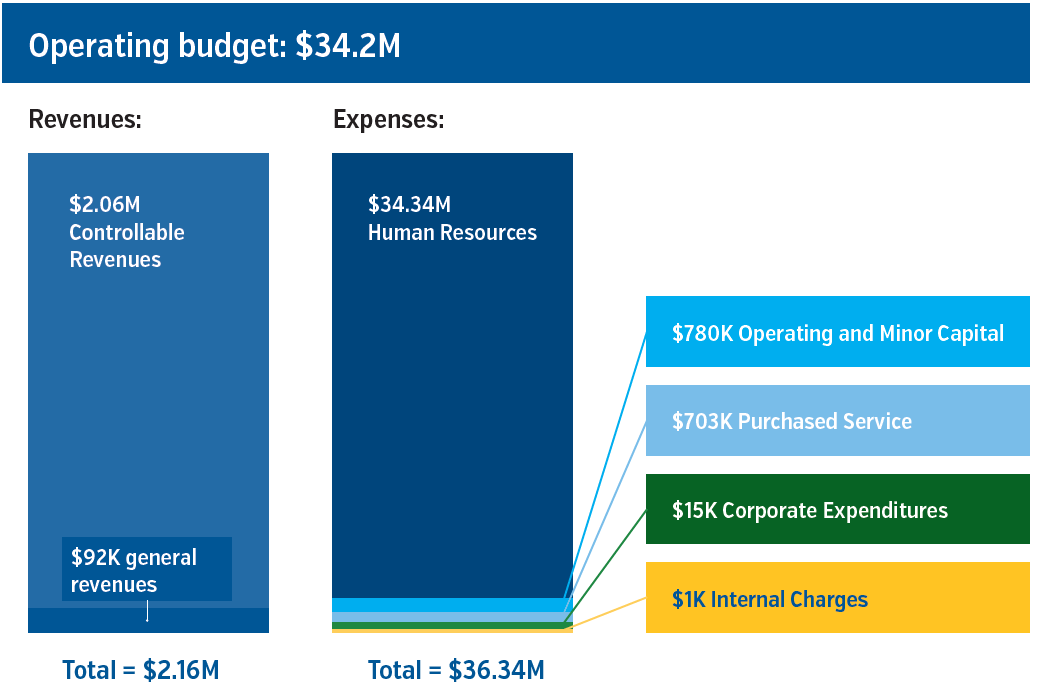 This template sets out the fundamentals.  With this level of data people can ask questions that are focused on a specif cost.
 The part of the budget where staff can expand on what has been presented.
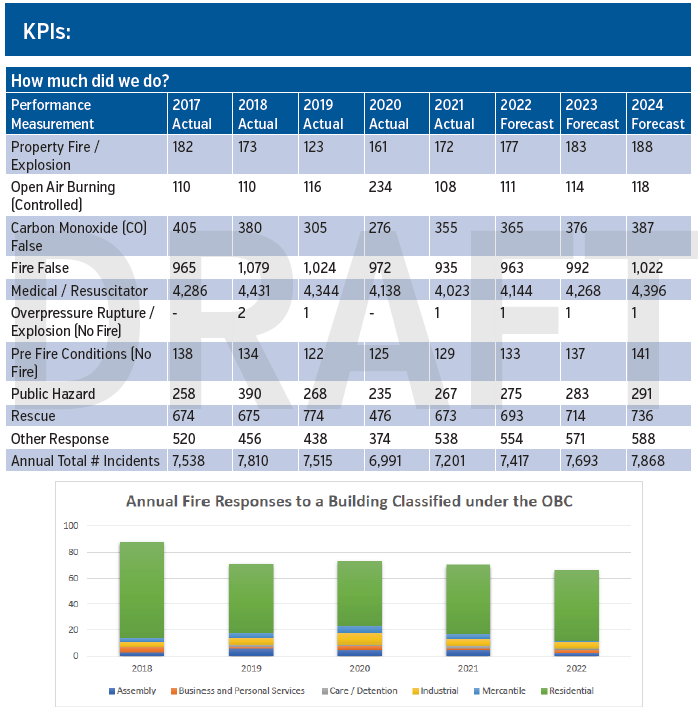 KPI’s Key Performance Indicators – The public hasn’t see data like this about the fire department.
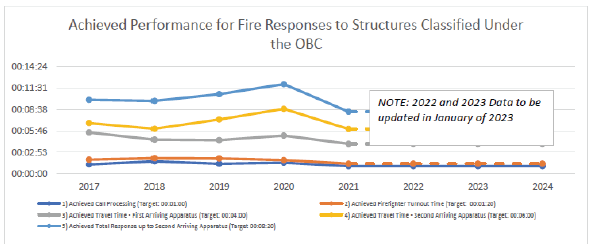
The thinking on budget/finance matters at this point is to dedicate a period of time during every Council meeting cycle (once a month) that will focus on budget issues. Opening that up to the public would be very useful as well. Let the public know that this is the occasion when people can send in their questions.
Did this improvement in the flow of information to the public come about because of the pressure from angry tax payers or was the change the result of new leadership within the Finance department? Does it matter? What does matter is that the people picking up the tab have an opportunity to comment when it matters.
Related news story:
The Mayor’s budget – a different look

 By Staff By Staff
July 3rd, 2024
BURLINGTON, ON
Joseph Brant Hospital (JBH) is recruiting community members, who in the last three years have been a patient or are a family member of a patient at JBH, to join the Patient Family Advisory (PFA) Team.

PFAs volunteer their experience and feedback to work with JBH leaders and staff to ensure the perspectives of patients, families, and caregivers are considered and integrated into hospital service and quality improvement initiatives. By actively involving patients and their families, JBH teams better understand their unique experiences and identify opportunities for improvement.
“Being a PFA allows you to represent patients and families, ensuring their voices are heard and their needs are met,” said Hanadi Almasri, PFA and member of the Patient Family Advisory Council (PFAC). “Working alongside healthcare professionals and other committee members fosters a collaborative environment where diverse perspectives are valued and considered to enhance inclusion within healthcare settings.”
Over the past year, JBH successfully implemented 50 design and improvement initiatives all influenced by the valuable input of the PFAs, such as reviewing the visitation policy, new inpatient food services vendor selection, accessibility at JBH, Diversity, Equity and Inclusion (DEI) and the endorsement of JBH’s Patient and Family Guide. It’s an interesting document – you might want to take a look at it.
The engagement of PFAs is important in driving positive change, fostering a person-centred approach to care and shaping the future of healthcare delivery at JBH.
“This role gives you the opportunity to influence healthcare policies and practices, ensuring they are patient-centred and family-friendly,” said Almasri. “The input you share can lead to tangible improvements in the quality of care provided, and your experiences will influence positive changes. You will feel so proud of the achievements you see.”
 We recognize that individuals in underserved and underrepresented communities bring unique and valuable perspectives to healthcare. We encourage people from these communities to apply to join our Patient Family Advisory Team. Your feedback and perspectives are crucial in helping us improve our hospital and better serve our community. We look forward to working alongside you. We recognize that individuals in underserved and underrepresented communities bring unique and valuable perspectives to healthcare. We encourage people from these communities to apply to join our Patient Family Advisory Team. Your feedback and perspectives are crucial in helping us improve our hospital and better serve our community. We look forward to working alongside you.
Learn more about this role and apply here: josephbranthospital.ca/pfac
About Joseph Brant Hospital
Joseph Brant Hospital (JBH) is a full-service, academic community teaching hospital located in Burlington, Ontario, along the picturesque banks of Lake Ontario. It is a modern, state-of-the-art facility, serving residents in Burlington as well as surrounding communities of Halton Region, Hamilton, Waterdown, Flamborough, and Stoney Creek.
JBH’s skilled staff of 194 physicians, 2,062 full- and part-time staff and 200 volunteers are committed to providing exemplary care and living the hospital’s core values of Compassion, Accountability, Respect and Excellence.
JBH is a Clinical Education site in conjunction with McMaster University and a partner member of the Burlington Ontario Health Team. It is honoured to be recognized as one of Hamilton Niagara’s Top Employers for eight consecutive years.

 By Cameron Fisher By Cameron Fisher
July 3rd, 2024
BURLINGTON, ON
Sending money to a bank account, whether domestically or internationally, has become a routine task in our interconnected world.
However, there are several important considerations to keep in mind to ensure that your transaction is smooth, secure, and cost-effective. After all, it’s your hard-earned money, and you don’t want anything to go wrong in the process. To help you out in making secure transactions to a bank account, here are five key factors to consider.
 1. Exchange Rates and Fees 1. Exchange Rates and Fees
One of the first things to check when sending money to a bank account is the exchange rate and any associated fees. Exchange rates can vary significantly between providers and can impact the amount received by the recipient.
Look for services that offer competitive rates and transparency regarding fees. Sometimes, a seemingly low fee might be offset by a less favourable exchange rate, so compare the total cost of the transaction across different providers. This way, you can send money to bank account by ensuring the lowest possible cost of the transaction.
2. Transfer Speed
Consider how quickly you need the money to reach the recipient’s bank account. Transfer speeds can vary from instant transfers (often with higher fees) to several business days for standard transfers. Also, instant transfers require extra transaction fees as compared to normal ones.
Factors such as the destination country and the provider you choose can influence transfer times. If time is critical, opt for services that offer expedited or instant transfers, but be prepared to pay a premium for this convenience. This option can come in handy when you are sending money to meet emergency expenses.
3. Security and Reliability
 Look for reputable companies with a track record of reliability and positive customer reviews. Security is paramount when it comes to transferring money. Ensure that the service or provider you choose has robust security measures in place to protect your financial information and transactions.
Look for reputable companies with a track record of reliability and positive customer reviews. Avoid unverified or lesser-known services, especially for large transactions, as this will increase your risk of anything going wrong with your money.
4. Recipient Details and Verification
Accurate recipient information is essential to ensure the funds reach the intended bank account. Double-check the recipient’s bank account number, IBAN (International Bank Account Number), SWIFT/BIC code (for international transfers), and any other relevant details required by the service provider.
Many providers also require identity verification of both the sender and the recipient to comply with regulations and prevent fraud. Make sure to provide the correct details to the service provider in order to prevent fraud.
5. Regulations and Restrictions
 Make informed decisions and achieve your financial goals effectively. Different countries have varying regulations and restrictions on money transfers, especially for international transactions. Familiarize yourself with any limits on the amount of money you can send, reporting requirements, and potential taxes or fees imposed by authorities.
Ensure that your chosen service provider complies with these regulations to avoid delays or complications with your transfer.
Whether you are sending money for personal reasons, business transactions, or other purposes, these considerations will help you make informed decisions and achieve your financial goals effectively.

 By Pepper Parr By Pepper Parr
July 2nd, 2024
BURLINGTON, ON
Burlington celebrates the 35th Twinning Anniversary with Itabashi, Japan this year. To commemorate the milestone, Itabashi Mayor Takeshi Sakamoto and other city officials will visit Burlington over the Canada Day weekend (June 29 – July 2, 2024), and Mayor Meed Ward along with other city representatives (six of them) will visit Itabashi, Japan in October 2024.
A twinning agreement between Burlington and Itabashi was signed at Burlington City Hall by Mayor Roly Bird and Mayor Keizo Kurihara on May 12, 1989. The relationship has flourished and remained strong since then through official delegation visits, citizen exchanges, gift exchanges, student pen pal and art exchange programs and memorable anniversary celebrations.
 A luscious garden in the city that commemorates the relationship with twin city Apeldoorn. The City of Burlington is also twinned with the City of Apeldoorn, the Netherlands since May 2005.
Burlington’s twin city relationships are actively supported by members of the Burlington Mundialization Committee – an established committee of Burlington City Council. Volunteer members of the committee coordinate a number of events annually to promote the twin city cultures with a broader goal of promoting Burlington as a world community dedicated to the United Nations philosophy of peaceful cooperation between people of the world through the understanding of different cultures.
The Mundialization Committee hosts the annual Sakura Festival and Canada Netherlands Friendship Day events and organizes pen pal and art exchanges with elementary and high school students. They also coordinate cultural events in cooperation with the Burlington Public Library such as haiku, ikebana and anime workshops. The Mundialization Committee fosters relationships with the Consul-General of Japan’s office and the Japan Foundation and Japanese cultural groups. The work of the Mundialization Committee is a major contributing factor to the strength of the relationship for more than 3 decades.
Another major contributor to the strength of the twinning relationship has been the bond with citizens. The late Itabashi citizen Taroo Enomoto made an annual financial contribution to Burlington, directed to charities benefiting women and children, for more than 30 years. He also donated the Rhododendron Garden found at Paletta Mansion. The late Kan Nakazawa donated the Sakura trees found at Spencer Smith Park and along Itabashi Way. He has also given generously to the Burlington Art Centre Building Fund and funds a scholarship for international studies presented annually by the Rotary Club of Burlington – Lakeshore each year. The ongoing activities and exchanges have contributed to the strong twinning relationship that exists between city officials, staff and citizens.
 Mayor Meed Ward was strutting her stuff in a parade that took place on the streets of Itabashi the last time a twinning event took place. On February 26, 2007, Council approved clerks department report and the framework for managing twin city relationships. The framework outlines the parameters for hosting twin city delegations and for participating in official visits to Burlington’s twin cities. The 2007 approved framework outlined that the City of Burlington would celebrate the anniversary of twin city relationships once every five years, including the 25th year, and that after the 25th year, twinning anniversary celebrations would only occur every 10 years.
On December 11, 2017, Council approved an amendment to the City of Burlington framework for managing twin city relationships to permit the celebration of twinning anniversaries every five years.
2024 marks the 35th anniversary of the twinning relationship between Burlington and Itabashi. Planning has been underway for several months with staff at the City of Itabashi – Culture and International Exchange Foundation. Events being planned at this time include:
- An Itabashi official delegation visit to Burlington during the Canada Day weekend from Jun. 29 – Jul. 2, 2024.
- A Burlington official delegation visit to Itabashi to participate in twinning celebrations being held from October 17 – 20, 2024.
Both cities are arranging commemorative events that showcase the twinning relationship and the respective cultures to their citizens, and both cities will present a city gift with the maximum value of the gift agreed to mutually between cities.
In accordance with the approved framework for managing twin city anniversary celebrations, an official Burlington delegation to Itabashi would consist of the Mayor (or designate), the Council’s appointed representative to the Burlington Mundialization Committee (or designate), Chair or Vice-Chair of the Burlington Mundialization Committee, Chair of the Itabashi sub-committee and two city staff responsible for the twin city relationship.
In accordance with the approved twinning framework, the City of Burlington will cover the airfare, accommodation, transfer and per diem costs for 6 delegates to travel to Itabashi, Japan to participate in 35th anniversary twinning celebrations. The City of Itabashi has defined Oct. 17 – 20, 2024 as their hosting dates. The cost of an official city gift will also be covered. During the visit to Itabashi, Mayor Meed Ward will present an official gift to the City of Itabashi.
 The late Kan Nakazawa donated the Sakura trees found at Spencer Smith Park and along Itabashi Way. He has also given generously to the Burlington Art Centre Building Fund and funds a scholarship for international studies presented annually by the Rotary Club of Burlington – Lakeshore each year. A current estimate for the travel expenses for one individual travelling to Itabashi (air, hotel and transfers) is approximately $3000.00. This number is subject to change. Once the travel cost per person is identified, any change fees or additional travel arrangements will be at the expense of the individual.
The purchase of the city gift is generally in the range of $1200 to $1500 and is sourced locally.
Travel expenses for the Burlington delegation and purchase of the city gift will be funded from the Mundialization Reserve Fund. The uncommitted balance in the Mundalization reserve fund is $223,759 as of March 31, 2024.
A couple of questions:
Is this the time to be doing something like this? Tax payers are beginning to holler about spending levels.
The cost of the trip comes in at about $20,000 – that total doesn’t appear in the report from the City Clerk.
And why is there $223,759. in the reserve fund?
Might this be a good time to revert to the once every ten year celebration that was the practice ?

 By Pepper Parr By Pepper Parr
July 2, 2024
BURLINGTON, ON
With what passes for a snappy headline the city communications people want to know what you thought of the fireworks/drone presentation on Canada Day?
 How much did this cost? Canada Day fireworks and drone display – y’eh or n’eh?
The City is looking for feedback on the use of drone and firework displays for Canada Day through an online survey at getinvolvedburlington.ca/dronesurvey. The survey is open now until July 9.
This year was the first time the City has used a drone display as part of the Canada Day festivities. The drone display was done before the traditional fireworks display.
The feedback gathered from the survey will be used to evaluate the two displays’ effectiveness and measure residents’ desire to expand the use of drones or continue with a traditional fireworks display in future years.
A report to Council was submitted March 4. A follow-up report will be going to Council with a recommendation on future use of drones and fireworks in the fall.
Telling the public how much was spent might help people decide what they are prepared to pay for.
To take the survey, visit getinvolvedburlington.ca/dronesurvey.
Angela Paparizo, Manager of Arts and Culture asks: Should we combine drones and fireworks again, or choose just one? That’s what we need to hear from residents.”

|
|
 “This new map is a great way to connect people across the province to local Ontario-made products and support the hundreds of Ontario businesses and thousands of Ontario workers who make these products and serve customers each and every day,” said Premier Doug Ford. “It also supports our plan to offer consumers the kind of choice and convenience available to other Canadians when purchasing alcoholic beverages, starting later this summer. I hope people across the province will take this chance to shop local and responsibly enjoy some great Ontario-made products!”
“This new map is a great way to connect people across the province to local Ontario-made products and support the hundreds of Ontario businesses and thousands of Ontario workers who make these products and serve customers each and every day,” said Premier Doug Ford. “It also supports our plan to offer consumers the kind of choice and convenience available to other Canadians when purchasing alcoholic beverages, starting later this summer. I hope people across the province will take this chance to shop local and responsibly enjoy some great Ontario-made products!” The new convenient and easy-to-use map can help users find a location that sells beer, wine, cider, spirits or ready-to-drink beverages. The map will be updated regularly as alcohol sales are expanded to more licensed grocery and convenience stores. As LCBO retail stores re-open, these will also be added to the map.
The new convenient and easy-to-use map can help users find a location that sells beer, wine, cider, spirits or ready-to-drink beverages. The map will be updated regularly as alcohol sales are expanded to more licensed grocery and convenience stores. As LCBO retail stores re-open, these will also be added to the map.
























































































